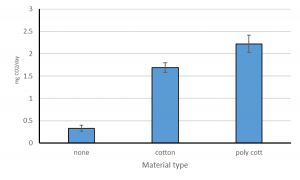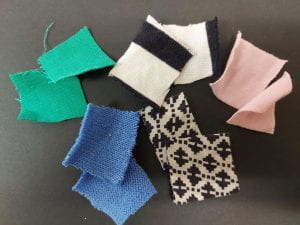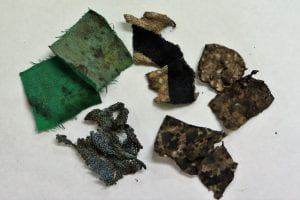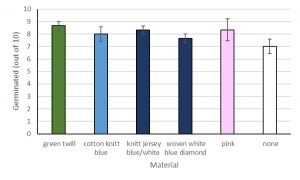Soiling and not landfilling
It’s been weeks since we received the soil and material samples from Goondiwindi. In that time we have conducted a soiling experiment to look at the effect the material had on the soil biology and in turn what impact the biology had on the material, by measuring the soils respiration . The experiment involved burying 2 cm squares of the material in 40 g of moist soil and incubating it at 20oC for eight weeks. Our buried swatches were equivalent to burying between 400 kg to 3 tonnes of material per hectare of farm land, which is the equivalent of removing 2,500 to 20,000 T-shirts from landfill (based on average T-shirt weight of 150 g) or up to 3,750 pairs of jeans!
So what did we find?
Oliver had put together a little video explaining what we did an observed at the end of the eight week incubation.
So what we were looking for is a more active soil biology, which is breaking down the cotton fibres into glucose (a sugar that the soil biology then eats) and the more active the biology is the better the effects are believed to be for the soil. This process also allowed us to see if the dyes in the cotton had an impact on the process and to make some assumptions as to whether the weave might also be important.
Fabric fate
The soil respiration clearly showed that the soil responded to having the material buried it and that the amount of activity also changed between the first and second four weeks of the experiment. Despite this, the overall trend was that a higher level of respiration occurred from the poly cotton material, which was a surprise as the microbes can’t break down the polyester. It is possible that the weave or inclusion of the polyester in the poly cotton may have permitted better access of the microbes and their enzymes to the cotton that was there.

The average respiration of the soil and its response to cotton and poly cotton swatches being buried
Another thought was that perhaps the dye in this material might have been released, also stimulating the microbial activity. To assess this we had also considered the dyes during the experiment.
Dyeing to know the outcome
Dyes need to balance their colour fastness with their potential environmental impact and a lot of dyes used today so this far better than those of only a few decades ago. Despite this, we still wanted to know if they might have an affect on the soil biology.
Initially the blue and pink dyes appeared to stimulate the most activity, and given the poly cotton was pink our ideas about the pink dye possibly stimulating the biology may well be true. However, in the second four weeks of the experiment the blue and royal blue dyed materials had higher microbial activity. The changes in the second eight weeks actually meant that the royal blue and pink dyed material stimulated the microbes the most, then the blue and with the least stimulation coming from the green material. These results were all higher than the bare soil readings, so it does not appear that any of the dyes had a harmful effect on the soil biology. The lack of stimulation from the green dyed material is more likely to have come from that material being from a heavy drill shirt material, whereas the others were all much lower thread weight and lighter weave. In other words the microbes had to work harder on a tighter and denser material to access the glucose and the result was a lower level of activity.
From soiling to seed
So, the experiment was going well, but we still had not completely broken down the fabric, which might cause some issues for on farm operations, but we have a few ideas about how to overcome them.
Something we did have to address though was whether having soiled the cotton, if we then planted cotton seed would it germinate that same? The answer was yes!
Closing the cycle and this article
In summary, the findings to date show that the burying of the cotton material has increased the soil microbial activity, which may have other positive effects on the soil in terms of structural stability and mineral cycling. This increase in activity does mean an increase in carbon dioxide (CO2) being respired from the soil during the experiment, but whilst CO2 is a greenhouse gas it is 28 times less potent than methane, which may be produced if the material was sent to landfill instead. Soiling the material also had no deleterious effect on the ability to germinate our crop seeds, which will be important if we are to successfully cycle our cotton back to our cotton fields. So all in all, it’s starting to look like we might be getting to closing the clothing loop when it comes to cotton.







This is highly interesting, especially what it comes out from polycotton and dyes. Would you like to proceed a full compostability – including home compost – as well according to ASTM? From a Cradle to Cradle prospective cotton fabrics are biological nutrients as you know, and only chemicals can make it not suitable to be returned to soil, including the presence of pesticides. If possible I would to talk to you an Olivier, if this can work at a scale and they are not bio-accumulative and edafological issues, it might be an alternative to more expensive compostability tests.
Great findings Oliver!
This is profoundly fascinating, particularly what it emerges from polycotton and colors. Might you want to continue a full compostability – including home manure. | momentum rentals